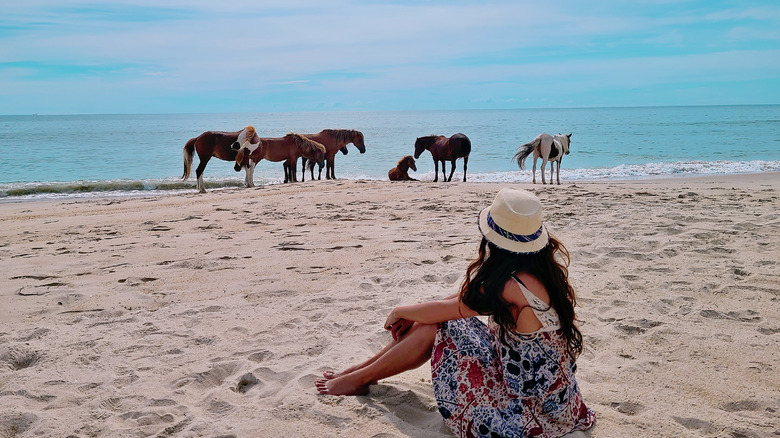Visit This Underrated Southern Beach Town And Catch A Glimpse Of Wild Horses
The Rolling Stones once sang, "Wild horses couldn't drag me away," and you're going to feel exactly the same when you find your way to the Southern beach town of Chincoteague Island, Virginia. This underrated and overlooked East Coast beach may not have Miami's sun-tanned bodies in bikinis, but it is possibly the best place in the continental US to spot wild horses, particularly the Chincoteague Ponies. These stocky wild horses have been inhabiting the Virginia and Maryland region for hundreds of years and you've probably already heard of them. Author Marguerite Henry made them famous in her 1947 children's book, "Misty of Chincoteague," per the Associated Press. Their annual migration across the Assateague Channel has been drawing in thousands of people for nearly a century. Chincoteague Ponies, which actually inhabit the adjacent Assateague Island, are managed by the Chincoteague Volunteer Fire Company, and you can spot them by taking a guided boat tour, or a pony tour.
Chincoteague Island is great for those who love adventuring in the great outdoors. Local guides offer tours to spot the wild ponies by kayak. Additionally, Chincoteague's official website provides a detailed map for biking and hiking the island to get the greatest vantage point for spotting the horses in areas that cars aren't allowed to pass.
Make sure you keep a safe distance from the wild horses
National Geographic posted a riveting video of the Chincoteague Ponies swimming across the Assateague Channel on YouTube, and if that isn't enough to pique your interest, perhaps their exciting history will. In 1947, author Marguerite Henry's wrote in "Misty of Chincoteague" that the ponies first came to the region during a 17th century Spanish transport that shipwrecked off the coast of Virginia. "The seasons came and went," Henry wrote in the book, "and the ponies adopted the New World as their own." While Henry was just writing fiction, she may have been on to something. The Atlantic reports that archaeologists unearthed a horse tooth from a 16th century Spanish colony, and subsequent DNA tests revealed that its closest relative is — you guessed it — the Chincoteague pony.
Today, the wild horse population is controlled by an annual auction held by the Chincoteague Volunteer Fire Company so the herds stay manageable while still thriving. The best part of visiting Chincoteague Island for wild pony spotting is that you could conceivably see them at any time of day, although its recommended you plan your trip sometime between April and October. If you are lucky enough to spot them, make sure you respect their well-being and safety by observing them from a safe distance. Feeding or approaching the legendary ponies is not allowed.
